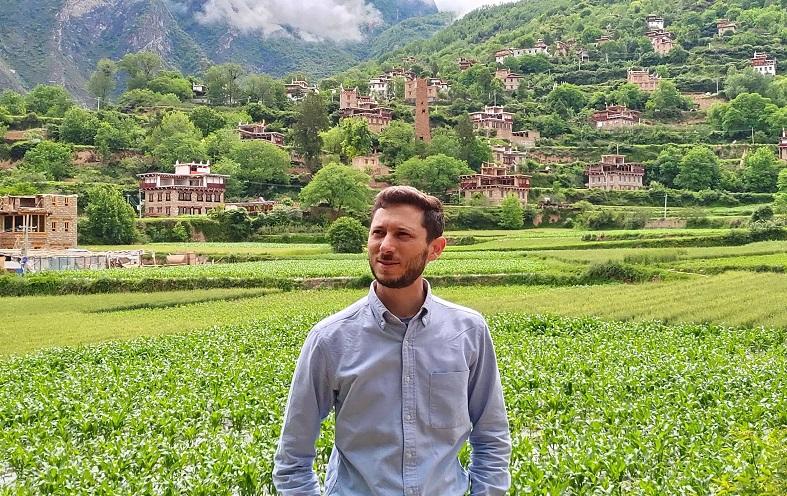
How does the Global Sustainable Tourism Council (GSTC) function, and how does it support the global travel industry?
We asked Roi Ariel, the organization’s General Manager, who in this interview illustrates the services provided by GSTC, in addition to highlighting examples of good practice and discussing the future of sustainability in the face of travel being turned upside down through the 2020 coronavirus pandemic.
Roi, given the variety of experiences you have had in your career so far, when did you first discover your passion for sustainable tourism?
Years ago, while travelling in Laos, I encountered an inspiring idea. I found myself in the canopy of a rainforest, for three days, surrounded by the breath of active conservation. I, and a small number of other tourists, ate local food, learned secrets of Lao culture and history, and immersed ourselves in protected, primary forest.
It was only later that I understood a broader picture of my trip. I was part of the active conservation of primary forest and the economic development of the area’s local population. That was a unique ecotourism project.
On the same months-long trip, a journey along the Mekong River, I came to notice the good and bad effects of tourism.
A few years later, I wrote my bachelor thesis at university about the effects of ecotourism on achieving the Millennium Development Goals. This included successful development models, in which tourists paid local tour operators to observe elephants in the wild. Income from tourism benefited local communities and incentivized the environment and habitat conservation.
One thing led to another and within a few months, I was working with a small ecotourism operator in China. Because of their size, they had little access to best practices. I realized how much impact could be achieved by including these operators in our global sustainability efforts.
How has your view on sustainability and tourism changed over the years?
In the beginning, I focused on ecotourism. However, I slowly came to realize that as a niche segment in tourism, its impact on the whole travel industry is not enough.
I also began to challenge a perception of many ecotourism professionals that “ecotourism is the fastest-growing segment in tourism” – an inaccurate statement that is not based on any statistics. I tried to trace the sources and citations and found no proper reports behind this hollow statement.
My focus slowly shifted to “sustainable tourism”, as all forms of travel should be made sustainable. Sustainable tourism is about applying sustainability practices to all aspects and segments of tourism (this is a good post about the difference between ecotourism and sustainable tourism). In that sense, my work can be more inclusive and impactful.
Cities remain the main destinations of travellers. We travel mostly to cities, not to places with tree houses, like in Laos. We should remember that tourism includes not only leisure travel, but also business travel, which sometimes receives less attention.
When a popular hotel in the city centre changes its operation to be more sustainable, it affects the consumption of thousands of guests (for instance they use less water or energy). A beautiful ecolodge in a province far from the capital might have only a handful of guests, and its impact may be smaller.
Multiply that city centre hotel, and the impact is tremendous. Sustainability must be mainstreamed.
That said, strategically-placed ecotourism initiatives are valuable for conservation generally, and the biodiversity and forests they save and communities they directly benefit are important.
For example, Cardamom Tented Camp in Cambodia is in a remote location with 100% of profits supporting park ranger stations with armed guards protecting the forest and wildlife, which is being destroyed in the surrounding area.
Currently, I believe that online travel agencies (OTAs) have the biggest potential to push sustainable tourism forward and bring a drastic change of demand from accommodations and tour operators to follow sustainability practices.
Thankfully, several prominent OTAs are GSTC Members (such as Booking.com, Agoda, and BookDifferent), with other OTAs showing interest in joining the movement.
Do you think that sustainability has become more of a marketing tool nowadays, or is it becoming a core component of business and destination strategies?
I think that both statements are true at the same time.
Sustainability became a buzzword and is sometimes used inaccurately, sometimes even in bizarre ways. I remember attending a conference recently where it felt as if each speaker tried to insert the word “sustainability” in every phrase, even if irrelevant, even if not really being applied. The highlight was an announcement by the hosts before a show during dinner “and now, for the sustainable cultural show!” they proclaimed.
On the other hand, more and more businesses and destinations do try to follow sustainability principles. However, sometimes that component is not mature and refers to simplistic concepts of sustainability. I hope more businesses and destinations will first refer to existing guidelines and plans to start with, without trying to reinvent the wheel.
Those businesses and destinations that are truly sustainable, do not use the term sustainability often but let their actions speak for them. Slovenia is doing that while promoting itself as green and friendly.
The Azores are doing similar things while having achieved certification as a sustainable destination by an entity accredited by GSTC.
Visit the websites of EXO Travel, Khiri Travel, or PEAK DMC, and you will find attractive messages of authentic and good products without overusing the term “sustainability”.
If you’re able to market sustainable products without mentioning the term sustainability, you’re doing it well.
GSTC is perhaps best known as “watchdog” over sustainable tourism certifications. What other services or benefits do you offer to destinations or tourism businesses once they become members?
The GSTC is managing the GSTC Criteria, the global standards for sustainable travel and tourism, as well as providing international accreditation for sustainable tourism certification bodies. GSTC does not certify directly. That’s the work done by these certification bodies.
Along with that, the GSTC became a rallying point for sustainability leaders in the industry and has a worldwide network of members, who represent a wide range of tourism stakeholders.
The GSTC has a large impact, but it is actually a small organization, with a strong membership network. Being a GSTC member means actively participating in GSTC’s global network, contributing to the work of the GSTC in promoting the widespread adoption of universal sustainable tourism principles.
Membership is open to all interested parties and does not by itself imply endorsement by the GSTC of the policies and practices of the member organization.
Being a member of the GSTC allows greater involvement in key decision-making processes, while also participating in and contributing to the efforts to advance sustainability in various sectors of the global travel and tourism industry.
It also serves as a platform to share best practices in sustainability, ensuring voices are heard by global practitioners – whether they are small or larger businesses, small island states or densely populated countries. GSTC Members are active drivers for sustainability in travel and tourism.
With the first set of GSTC Criteria having been developed in 2008 – how often do you revise or update the criteria to keep up with the fast pace of changes in the tourism industry?
The GSTC Criteria have been built on decades of prior work and experience around the world, and they take into account the numerous guidelines and standards for sustainable tourism from every continent. During the process of development, they were widely consulted throughout the globe, in both developed and developing countries, in several languages.
To remain relevant, the Criteria need to be revised regularly. When the first GSTC Destination Criteria were published in 2013, not many referred to issues of overtourism. A few years later, “overtourism” is a term widely used and needed to be addressed in Criteria revision.
With the current situation, I anticipate that in the next revision, many will suggest improvements to the crisis management criterion (which already exists in the Criteria).
Another example is a clear reference in the recently revised GSTC Destination Criteria v2 to contribute towards the 2030 Agenda for Sustainable Development and the 17 Sustainable Development Goals. Against each of the criteria, one or more of the 17 SDGs is identified, to which it most closely relates.
The process of developing and revising the Criteria is designed to adhere to the standards-setting code of the ISEAL Alliance, the international body guiding the development and management of sustainability standards for all sectors.
Thus, the GSTC conducts periodic reviews of no less than five years after the previous revision to determine whether the current version remains relevant and whether and when a formal revision process should commence. So far, a revision was made every 4-5 years to each set of criteria.
The revision process is very inclusive, and I invite all to participate in the public consultations of future revisions.
In which regions of the world do you see most interest and momentum for tourism sustainability?
Countries and cities doing the best are those working on sustainability broadly, not just focused on tourism but on sustainability for their residents’ and visitors’ well-being alike.
For example, Copenhagen is aiming to be carbon neutral by 2025, which requires that the tourism infrastructure is sustainable. Northern Europe – from Germany to the Netherlands and all the Scandinavian countries – are at the forefront of sustainable tourism practices. This region leads others in a combination of traveller awareness and concern, travel provider engagement, government regulation, and media focus.
On the other side of the globe, we see prominent countries in Asia-Pacific adopting global standards and institutionalizing sustainability in the tourism industry:
- Japan Tourism Agency announced its commitment to formally adopt GSTC criteria as part of its tourism policy.
- South Korea and Taiwan also have strategies and policies in place to support sustainability in tourism.
- Sri Lanka Tourism Development Authority (SLTDA) has established its National Sustainable Tourism Certification Scheme.
- Vanuatu has a well-established Sustainable Tourism Policy.
- Thailand’s Minister of Tourism and Sports announced in 2018 that looking at sustainability measurements is more crucial than counting tourists to measure success, while in 2019 the Thai Designated Areas for Sustainable Tourism Administration (DASTA) assessed several destinations according to the GSTC Destination Criteria while providing education on it to local destination management teams.
How much of this momentum will continue in the post-COVID-19 world, we’ll have to see.
Do you personally have any favourite business or destination which you think is leading the way in how it approaches sustainability?
There are plenty of amazing destinations and businesses to choose from, so let me speak about Taiwan (I might be a bit biased, as I have been living in Taiwan for about 5 years now).
The Northeast and Yilan Coast National Scenic Area Administration has been working with GSTC and Green Destinations for several years and thus has established and implemented a multi-year sustainable destination strategy. They also turned it into an accessible destination, putting wooden pathways during the Fulong Sand Sculpture Festival, providing chairs for people with movement disability to dip in the water, and providing special bicycles to enjoy the historical Old Caoling Tunnel bike trail.
Sun Moon Lake National Scenic Area Administration has been disseminating practical knowledge of sustainability, actively promoting adherence to the GSTC Criteria by the private sector.
Many Taiwanese restore old structures and make them into trendy shops that are both profitable and maintain cultural traditions. One such example is the Neiwan Theater that was built over an old lumberyard during the Japanese colonial era. In 2002, it was converted into a restaurant that screens Taiwanese films from the 1970s, while serving local cuisine.
Taiwan is also the home to a diverse group of indigenous people, 16 formally recognized groups that speak about 22 different languages of the Austronesian language family. Many communities participate in tourism.
Compared to other indigenous peoples in Asia, those in Taiwan nowadays have good access to infrastructure, services, and education. This allowed a few communities to develop community-based tourism (CBT) ventures, where the community is in control of the situation and business, without the often common support from international organizations.
A famous example of this is the success story of the Atayal village of Smangus that established a kibbutz-like cooperative, combined with its traditional law. While protecting the surrounding forests with its ancient Formosan Cypress trees, the community invites guests to learn its belief system, language, and traditional knowledge. It is one of the two communities with two different CBT models that I compared in my thesis research that looks into their Common Pool Resource management and benefit distribution.
How has your work experience in organisations like Lijiang Xintuo Ecotourism Company, Ecopeace, Wild Asia, United Nations ESCAP, and PATA prepared you for your current role as General Manager of GSTC?
Skills and experiences in multiple disciplines are very useful, healthy, and helpful when coming across new challenges.
Working with a small ecotourism tour operator in China gave me more experience in working under a tight budget. Ecopeace is an organization that fosters collaboration between Israelis, Palestinians, and Jordanians. Needless to elaborate on the challenges and barriers, but that definitely helped me to see solutions in conflicting situations.
The time at United Nations ESCAP was fantastic to gain experience in a truly multicultural work environment. Having a superior from Saudi Arabia with coworkers from all over the world is not something I expected a few years back while living in Israel. In my current role at GSTC, I have been interacting with colleagues and counterparts from every region in the world.
PATA has a very strong network of members, which allowed me to grow my contacts in the Asia Pacific region along with learning the good practice of maintaining satisfied and engaged members. It shows commitment to sustainability and constantly improves the organization.
I joined the GSTC in 2016, and within a few months, I was given the responsibility to be the General Manager of the organization.
What’s it like to work with the GSTC – can you describe a typical day, as General Manager?
Here’s a day from last week: starting with a 7:00 am conference call with the hosts of the GSTC 2020 Conference in Kelowna, BC, Canada (I act as the lead person in planning, organizing, and executing the GSTC conferences).
Then spending some time on operational issues – communicating with the GSTC staff (CEO, Operations Manager, Membership Coordinator, etc.), planning webinars, communicating with certification bodies and leading technical upgrades of the GSTC website (I used to be a programmer and a technician of communication systems in the past).
Then I joined a roundtable on ‘Reducing Plastic Waste in the Hospitality Industry’ hosted by UNEP and attended by several GSTC Members. As mentioned above, GSTC’s membership is crucial, and GSTC Members set an example and promote the industry to adhere to sustainability standards.
As I also manage all of the communication aspects of GSTC (including branding, social media and newsletters, internal communication, and website design and maintenance), I spent the evening preparing the GSTC monthly newsletter that is sent to thousands of followers.
All of my work I do as part of dedicated staff and members throughout the world, to grow and improve the GSTC, and thus grow and improve adherence to the sustainable tourism standards set by the GSTC.
I’m very glad to be able to make a meaningful contribution to this cause and I’m grateful to be able to learn from our CEO, Randy Durband, and the rest of the inspiring GSTC team.
What tips or suggestions do you have for those who want to engage with sustainable tourism business practices, but don’t know where to start?
Visit the GSTC website!
We structured the website in a way to make it easy to engage with sustainable tourism practices. There are three dedicated pages: for hotels and accommodations, for tour operators, and governments and destinations. These pages include a simple guiding path – from learning the GSTC Criteria to becoming a certified sustainable business.
The GSTC Criteria have also been translated into many languages, to make them accessible to more people. Any business can begin by downloading the relevant Criteria (Industry or Destination), learn from it and see what can be applied in its operations.
There are many resources out there offered by prominent organizations. For those who want to gain in-depth knowledge of the GSTC Criteria, I would recommend joining an on-site or online class of the Sustainable Tourism Training Program (STTP). It offers practical insights and effective steps to help improve sustainability practices.
Thank you, Roi.
Connect with Roi on LinkedIn or follow him on Twitter or Instagram.
Enjoyed our interview with Roi Ariel of the Global Sustainable Tourism Council? Thanks for sharing!











